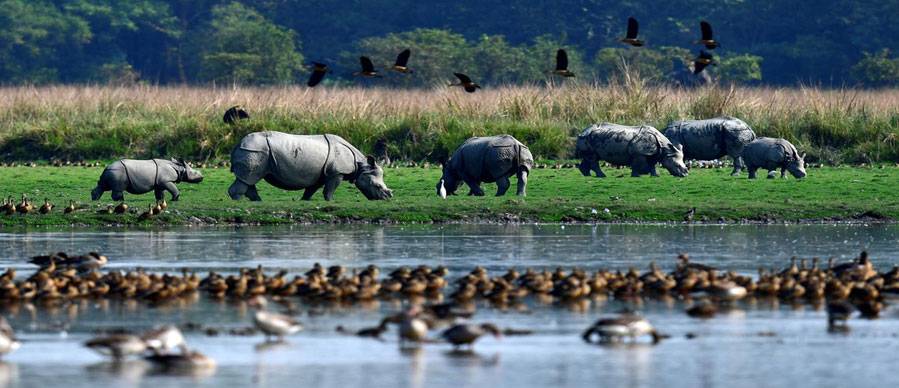Pobitora Wildlife sanctuary: Most Visited Tourism Spot in Assam
By JAGAT [21/June/2024] Pobitora Wildlife Sanctuary is a lesser-known but equally captivating gem in India’s rich tapestry of wildlife heritage. Spanning an area of approximately 38.81 square kilometers, this sanctuary may be small in size, but it is incredibly significant in terms of biodiversity and conservation efforts. Here, the lush grasslands, marshes, and wetlands create a vibrant mosaic of habitats, home to a plethora of wildlife species, including the majestic Indian rhinoceros. Located in the northeastern state of Assam.
The Indian Rhinoceros: Pobitora’s Pride
Pobitora Wildlife Sanctuary is often referred to as the ‘Mini Kaziranga’ due to its impressive population of Indian rhinoceroses. Despite its limited area, the sanctuary boasts the highest density of rhinos in the world. This is a remarkable achievement in conservation, considering the ongoing threats of poaching and habitat destruction faced by these gentle giants. The sight of these magnificent creatures grazing in the vast grasslands of Pobitora is nothing short of awe-inspiring. For wildlife enthusiasts and photographers, this sanctuary offers unparalleled opportunities to observe and capture the behavior of rhinos in their natural habitat.

A Biodiversity Hotspot
While the Indian rhinoceros is the star attraction, Pobitora is a sanctuary teeming with diverse wildlife. The sanctuary’s wetlands and grasslands provide an ideal habitat for a variety of bird species, making it a haven for bird watchers. Over 200 species of birds have been recorded here, including resident and migratory birds. Among these are the Indian roller, greater adjutant stork, and several species of ducks and herons. The presence of these avian species highlights the ecological importance of Pobitora as a critical stopover point for migratory birds.
In addition to birds and rhinos, Pobitora is home to other notable wildlife such as wild boars, Asiatic buffaloes, leopards, and various species of reptiles and amphibians. The sanctuary’s diverse flora and fauna create a complex and thriving ecosystem that is crucial for maintaining the ecological balance of the region.
Conservation Efforts
Pobitora Wildlife Sanctuary’s success in rhino conservation is a testament to the dedicated efforts of the Assam government, local communities, and various conservation organizations. Anti-poaching measures, habitat management, and community involvement have been pivotal in safeguarding the sanctuary’s wildlife. The establishment of buffer zones and the promotion of eco-tourism have also played significant roles in ensuring the sustainability of conservation initiatives. Eco-tourism, in particular, has provided alternative livelihoods for local communities, fostering a sense of stewardship and active participation in wildlife conservation.
Visiting Pobitora Wildlife Sanctuary
For those seeking an authentic wildlife experience, Pobitora Wildlife Sanctuary is a destination that should not be missed. The sanctuary is easily accessible from Guwahati, Assam’s largest city, making it a convenient getaway for both domestic and international tourists. The best time to visit is between November and March when the weather is pleasant, and wildlife sightings are more frequent.
Visitors can explore the sanctuary through jeep safaris and elephant rides, which offer unique perspectives on the landscape and its inhabitants. Additionally, boat rides on the nearby Brahmaputra River provide opportunities to witness the sanctuary’s beauty from a different vantage point.
Conclusion
Pobitora Wildlife Sanctuary is a testament to the rich wildlife heritage of Assam and the success of conservation efforts in India. It is a place where one can witness the majesty of the Indian rhinoceros and the vibrant diversity of birdlife amidst serene natural surroundings. As a beacon of hope for endangered species and a sanctuary for countless forms of life, Pobitora stands as a vital reminder of the importance of preserving our natural heritage for future generations.

 +91-9599553197
+91-9599553197  info@pobitorawildlifesanctuary.in
info@pobitorawildlifesanctuary.in

